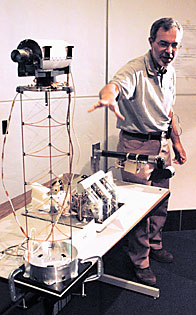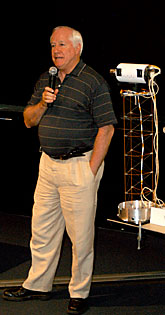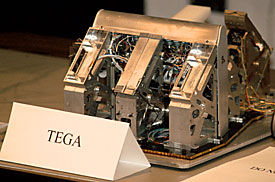 |
|
JACOB KONSTArizona Summer Wildcat
|
Staff Engineer Roger Tanner explains the functions of the displayed sections on the Mars lander at a press conference Monday.
|
|
By Ian Musil
Arizona Summer Wildcat
Wednesday August 6, 2003
UA awarded largest grant in school history to explore Mars further
In March 2001, UA scientists helped find water on Mars. In May 2008, they will help look for life.
The National Aeronautics and Space Administration (NASA) announced Monday that the University of Arizona was awarded a $325 million grant ÷ the largest grant in UA history ÷ to study water and organic molecules just beneath the surface of the planet.
The unmanned "Phoenix" mission includes major contributions from Lockheed Martin and other subcontractors who get a portion of the NASA funding. Michael Drake, director of the UA's Lunar and Planetary Laboratory (LPL), the department receiving the grant, said the rest of the funds, about $120 million, will be spent in Tucson over the next three years.
Peter Smith, a principal investigator on the project, was excited when he announced the achievement at a press conference Monday.
"It was a photo finish and nerve-wrenching all the way," Smith said.
The UA proposal made it into the final four for selections late last week. Competitors in that group included projects presented by researchers at Arizona State University, NASA Langley Research Center in Virginia and NASA Jet Propulsion Laboratory in California.
The UA, with its previous connection to the 2001 discovery on the Red Planet, won NASA's confidence in a unanimous vote.
 |
|
JACOB KONSTArizona Summer Wildcat
|
U.S. Rep. Jim Kolbe (R-Ariz.) speaks at a press conference regarding UA's grant to develop a Mars lander.
|
|
NASA's 2001 Mars Odyssey orbiter included an instrument built by planetary sciences professor William Boynton and his UA colleagues. About a meter down under the planet's southern pole, Boynton's instrument found vast amounts of what appears to be frozen water. Making up more than 50 percent of the soil's mass, the water ice would fill Lake Michigan twice.
Although the primary goal of the Phoenix mission is to study the history and possible future of this water, investigators at the LPL say they are excited about the possibility of finding signs of life.
"Follow the water" is a favorite slogan of LPL investigators on the Phoenix project, who insist environments with water are the most likely to lead to any remnants of life on Mars.
In 1976, NASA's Viking Lander took soil samples from Mars surface, but found few indications of life on the planet.
"Those samples (Viking) collected were completely devoid of life's signature. It was the worst environment for life you could imagine," said Smith, who suggested not all of Mars is this inhabitable and that Viking scientists were inadvertently looking in the wrong place.
"Ice may have been 100 miles under the surface at the landing site for Viking," said Smith, who insists Phoenix won't have so far to go to reach frozen water.
LPL investigators said the loss of NASA's 1999 Mars Polar Lander was directly linked to the lack of significant data on the mission's landing site. The Phoenix mission will include a 2001 Lander originally designed to be part of the Mars Polar mission, canceled in 2001 after the crash, and researchers said more planning will go into its landing.
 |
|
JACOB KONSTArizona Summer Wildcat
|
This component is a piece of equipment that may be going to Mars on a UA-developed mission to Mars.
|
|
Investigators insisted the primary advantage of the Phoenix mission is recognizance researcher on the proposed landing site.
Odyssey and Global Surveyor are already orbiting Mars, and the Mars recognizance orbiter, built by the UA and being launched in 2005, will gather data from sensitive UA equipment to determine an exact landing site for Phoenix. Above the 65th latitude at the site or "sweet spot," as Boynton called it, frozen water rises to within inches of the planet's surface.
Equipped with a meter-long robotic arm, researchers said the Phoenix could dig through the dry surface of Mars to access the ice below. Once collected, small samples about the size of a toothpick are placed in an oven and heated to 1000 degrees Celsius to help researchers analyze content. Water will also be added to the samples to test how the Mars soil would react to wet conditions.
Although Drake said Phoenix will not directly seek to detect life, Smith is optimistic. Smith thinks warmer periods in the Mars atmosphere, due to inconsistencies in the planet's orbit, could have given life the opportunity to originate and go dormant before Mars cooled again.
"Microbial colonies can remain dormant for eons, yet survive. Recent work shows that dormant microbes are activated when water ice melts onto soil crystals at temperatures as cold as 20 degrees."
He cites the recent discovery of microorganisms living in "extreme environments" as further evidence.
"It's only been the last 20 years or so that we've found how much life is sequestered in the polar regions of Earth," Smith said. "It was thought that these areas were devoid of life, but biologists have found that all you have to do is scrape off the surface or break a rock in half to find whole communities of life existing."
Christopher Rensing, an assistant professor in the department of soil, water, and environmental sciences who works closely with bacteria that live in extreme environments, said that although bacteria can live in harsh environments, and he's seen some go dormant for 50 million years, he's hesitant to make any claims about life on Mars.
"It is sort of a stretch. I am glad we got the grant, but the likelihood of life on Mars is low."

